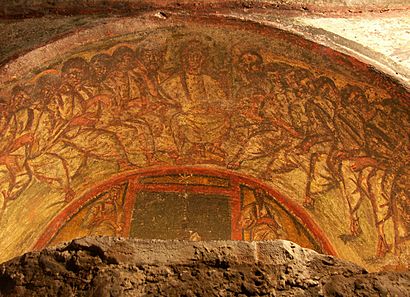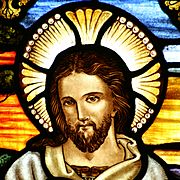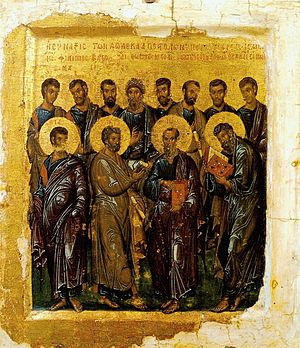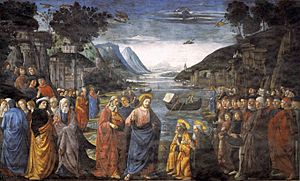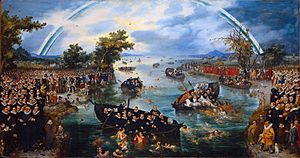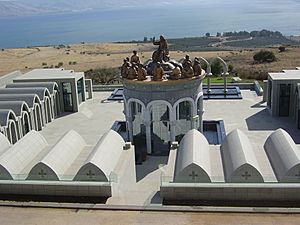Apostles in the New Testament facts for kids
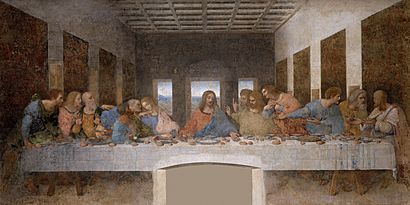
In Christianity, the Apostles, especially the Twelve Apostles, were the main followers of Jesus. They are also known as the Twelve Disciples or simply the Twelve. During Jesus's time on Earth in the 1st century AD, these apostles were his closest friends and became the first teachers of his message.
The New Testament describes how Jesus chose these twelve special followers. After Jesus came back to life (his Resurrection), he told eleven of them (because Judas Iscariot had died) to share his teachings with people everywhere.
Paul, even though he wasn't one of the first twelve, also called himself an apostle. He said that Jesus appeared to him after his resurrection and asked him to spread his message. Paul later became known as "an apostle to the Gentiles" (non-Jewish people). The time when the original apostles lived and taught is called the Apostolic Age.
Contents
Who Were the 12 Apostles of Jesus?
Here are the names of the twelve main followers Jesus chose:
- Simon (also called Peter)
- Andrew (Peter's brother)
- James (son of Zebedee and brother of John)
- John (son of Zebedee and brother of James)
- Philip
- Bartholomew (also known as Nathanael)
- Matthew (a tax collector, also called Levi)
- Thomas (also called "Didymus," meaning "twin")
- James (son of Alphaeus, to tell him apart from James, son of Zebedee)
- Simon (sometimes called "the Canaanite")
- Judas Iscariot (the one who betrayed Jesus)
- Jude (also known as Thaddaeus or Lebbaeus)
What Does "Apostle" Mean?
The word apostle comes from the ancient Greek word apóstolos. This word means 'messenger' or 'envoy'. It's more than just a simple messenger; it means someone who is sent out with an important task or message, like a delegate.
Stories from the Bible
The Bible tells us many stories about Jesus and his apostles.
Jesus Calls His First Followers

The Bible describes how Jesus first met some of his followers. Andrew and another follower of John the Baptist (thought to be John) heard John the Baptist talk about Jesus. They then followed Jesus and spent the day with him. This is how Andrew became known as "the first called" in some Christian traditions.
When Jesus asked them to join him, they immediately left their fishing nets to follow him. This shows how much they believed in him. Some of the followers, like Andrew, might have already known about Jesus.
Soon after, Jesus met James and John, who were also fishermen and brothers. They were repairing their nets but quickly joined Jesus. The Bible says they even left their father behind, showing how dedicated they were to Jesus.
Later, Jesus saw a tax collector named Matthew (or Levi). Tax collectors were not well-liked in Jewish society. Jesus asked Matthew to become his follower, and Matthew agreed. He then invited Jesus to eat with his friends. When some religious leaders asked why Jesus ate with such people, Jesus famously replied, "It is not the healthy who need a doctor, but the sick. I have not come to call the righteous, but sinners to repentance."
Jesus Chooses the Twelve
The Bible tells us that Jesus went up a mountain to pray. When morning came, he called his followers and chose twelve of them to be his apostles. He gave them special power to heal sick people and cast out evil spirits.
Here's how the Gospels describe this moment:
Then Jesus called his twelve disciples together. He gave them power over evil spirits and the power to heal every disease and sickness. These are the names of the twelve apostles: First, Simon, also known as Peter, and his brother Andrew; James son of Zebedee, and his brother John; Philip and Bartholomew; Thomas and Matthew the tax collector; James son of Alphaeus, and Thaddaeus; Simon the Cananaean, and Judas Iscariot, the one who betrayed him.
He went up the mountain and called to him those whom he wanted, and they came to him. And he appointed twelve, whom he also named apostles, to be with him, and to be sent out to proclaim the message, and to have authority to cast out demons. So he appointed the twelve: Simon (to whom he gave the name Peter); James son of Zebedee and John the brother of James (to whom he gave the name Boanerges, that is, Sons of Thunder); and Andrew, and Philip, and Bartholomew, and Matthew, and Thomas, and James son of Alphaeus, and Thaddaeus, and Simon the Cananaean, and Judas Iscariot, who betrayed him.
One of those days Jesus went out to a mountainside to pray, and spent the night praying to God. When morning came, he called his disciples to him and chose twelve of them, whom he also designated apostles: Simon (whom he named Peter), his brother Andrew, James, John, Philip, Bartholomew, Matthew, Thomas, James son of Alphaeus, Simon who was called the Zealot, Judas son of James, and Judas Iscariot, who became a traitor.
Lists of the Twelve Apostles
The Bible lists the Twelve Apostles in a few places. All lists show that the apostles were men. While the names are mostly the same, there are small differences. For example, the Gospel of Luke lists "Judas, the son of James" instead of "Thaddaeus."
The lists always group the apostles in the same way. Peter is always listed first, Philip is always fifth, and James, son of Alphaeus is always ninth. Judas Iscariot is always listed last.
The Gospel of John doesn't give a formal list of the twelve. It mentions "the Twelve" but doesn't name them all.
The New Testament mentions two pairs of brothers among the Twelve: Peter and Andrew, and James and John. Some traditions also say that James, son of Alphaeus and Matthew were brothers, and that James, son of Alphaeus, and Thaddaeus were also brothers.
| Gospel of Matthew | Gospel of Mark | Gospel of Luke | Gospel of John | Acts of the Apostles |
|---|---|---|---|---|
| Simon ("also known as Peter") | Simon ("to whom he gave the name Peter") | Simon ("whom he named Peter") | Simon Peter / Cephas "which is translated Peter" | Peter |
| Andrew ("his [Peter's] brother") | Andrew | Andrew ("his [Peter's] brother") | Andrew ("Simon Peter's brother") | Andrew |
| James ("son of Zebedee") | James ("son of Zebedee") / one of the "Boanerges" | James | one of the "sons of Zebedee" | James |
| John ("his [James's] brother") | John ("brother of James") / one of the "Boanerges" | John | one of the "sons of Zebedee" / the "disciple whom Jesus loved" | John |
| Philip | Philip | Philip | Philip | Philip |
| Bartholomew | Bartholomew | Bartholomew | Nathanael | Bartholomew |
| Thomas | Thomas | Thomas | Thomas ("also called Didymus") | Thomas |
| Matthew ("the publican") | Matthew / Levi | Matthew / Levi | not mentioned | Matthew |
| James ("son of Alphaeus") | James ("son of Alphaeus") | James ("son of Alphaeus") | not mentioned | James ("son of Alphaeus") |
| Thaddaeus (or "Lebbaeus"); | Thaddaeus | Judas ("son of James," referred to as brother in some translations) | Judas ("not Iscariot") | Judas ("son of James," referred to as brother in some translations) |
| Simon ("the Canaanite") | Simon ("the Cananaean") | Simon ("who was called the Zealot") | not mentioned | Simon ("the Zealot") |
| Judas Iscariot | Judas Iscariot | Judas Iscariot | Judas ("son of Simon Iscariot") | (Judas replaced by Matthias) |
Jesus's Closest Friends Among the Twelve
Peter, James son of Zebedee, and James's brother John were a special group among the Twelve Apostles. Jesus often invited only them to be present during important moments. These included the time he brought Jairus's daughter back to life, his Transfiguration (where he appeared in glory), and when he prayed in the Garden of Gethsemane before his arrest.
Later, in the early Christian Church, Peter, John, and James, brother of Jesus were seen as the main leaders. They were called the three Pillars of the Church.
Replacing Judas Iscariot
After Judas betrayed Jesus and died, there were only eleven apostles left. The Bible says that Peter suggested they choose a new twelfth apostle. They wanted someone who had been with them from the beginning of Jesus's ministry until his ascension into heaven.
They chose Matthias by casting lots, which was a way to ask for God's will. Matthias then became the new twelfth apostle.
Paul later wrote about Jesus appearing to "Cephas" (Peter) and then "to the twelve." This is one of the earliest historical mentions of the Twelve Apostles.
Other Apostles in the New Testament
The Bible also mentions other people who were called "apostles."
- Barnabas is called an apostle in the book of Acts.
- James the Just, Jesus's brother, is also referred to as an apostle.
- Andronicus and Junia are mentioned by Paul as being "of note among the apostles." This could mean they were important apostles themselves, or that they were well-known to the apostles.
The Seventy Disciples
The Bible also mentions "seventy disciples" (or seventy-two) whom Jesus sent out in pairs on a special mission. In Eastern Christian traditions, these seventy are also called "Seventy Apostles."
The word apostle means someone sent on a mission, while disciple means a student. Both titles fit these followers, but different Christian traditions use the words slightly differently.
Paul, the Apostle to the Gentiles
Paul was not one of the original twelve apostles chosen by Jesus during his life. However, after Jesus died and came back to life, he appeared to Paul (who was then called Saul) on the Road to Damascus. This event changed Paul's life, and he became a strong follower of Jesus.
Paul believed that Jesus himself had given him a special mission to spread the gospel to the Gentiles (people who were not Jewish). In his letters, Paul often called himself an "apostle." He also referred to his friend Barnabas as an apostle.
Paul often had to explain why he was an apostle, since he hadn't been with Jesus from the beginning like the original twelve. He said that he had seen Jesus and had received his message directly from him. Paul considered himself equal to the other apostles, even though he had once persecuted Christians.
Paul was known as the apostle of the Gentiles. The leaders in Jerusalem, including James, Peter, and John, agreed that Paul and Barnabas should focus on teaching non-Jewish people. Even though Jesus first sent the Twelve to Jewish towns, the "Great Commission" (Jesus's command after his resurrection) was to spread his message to "all nations." This shows that the apostles' mission was not just for Jews.
In a Christian sense, anyone who received a special mission from God or Christ could be called an "Apostle."
Deaths of the Apostles
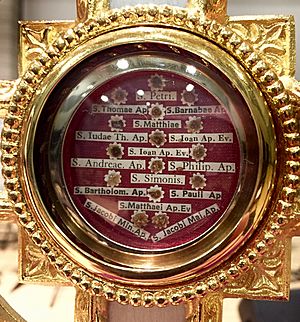
Christian tradition generally says that all of the Twelve Apostles, except for John, died as martyrs (meaning they died for their faith). It is believed that John lived to be very old and died naturally in Ephesus.
The Bible only describes the death of two apostles:
- James, the brother of John, was the first apostle to die. He was killed around AD 44. (Acts 12:1–2)
- Judas Iscariot died after betraying Jesus. The Bible says he threw away the money he received and then hanged himself. Another account says he fell and his body burst open.
Some historians believe that only Peter, Paul, and James, son of Zebedee, were definitely martyred. The stories about the deaths of the other apostles often come from later legends, not from the Bible or early historical records.
Where the Apostles Are Buried
Many churches in Europe and elsewhere claim to have relics (parts of the bodies or belongings) of the apostles. Here are some traditional burial sites:
- Andrew: Buried in the Cathedral of Saint Andrew in Patras, Greece.
- Bartholomew: Buried in the Basilica of Benevento, Italy, or Basilica of St. Bartholomew on the Island in Rome.
- James: Buried in Santiago de Compostela Cathedral in Spain.
- James: Buried in the Cathedral of St. James in Jerusalem or the Church of the Holy Apostles in Rome.
- John: No relics are known. It's believed his body was taken to heaven.
- Judas Iscariot: Buried at Akeldama near Jerusalem.
- Jude Thaddeus: Buried in St. Peter's Basilica in Rome.
- Matthew: Buried in the Salerno Cathedral, Italy.
- Matthias: Buried in St. Matthias' Abbey in Trier, Germany.
- Paul: Relics are in the Basilica of Saint Paul Outside the Walls in Rome. His skull is in the Archbasilica of Saint John Lateran.
- Peter: Buried in St. Peter's Basilica in Vatican City, Rome. His skull is also in the Archbasilica of Saint John Lateran.
- Philip: Buried in the Church of the Holy Apostles in Rome or possibly Hierapolis, Turkey.
- Simon: Buried in St. Peter's Basilica in Rome.
- Thomas: Buried in the San Thome Basilica in Chennai, India, or the Basilica of St. Thomas the Apostle in Ortona, Italy.
Legacy of the Apostles
By the 2nd century AD, being connected to the apostles was very important for showing authority. Churches that were believed to be started by an apostle are called apostolic sees.
Paul's letters became part of the Bible, and two of the four main Gospels are linked to apostles. Many other Christian writings were also said to be from the apostles. The Apostles' Creed, a popular statement of Christian belief, was even thought to have been written by the apostles themselves.
Christian Bishops today often trace their leadership back to the Twelve Apostles. It is believed that the apostles spread out from Jerusalem and started churches in many different places. Early Church leaders who were connected to the apostles, like Pope Clement I with St. Peter, are called Apostolic Fathers.
See also
 In Spanish: Apóstoles en el Nuevo Testamento para niños
In Spanish: Apóstoles en el Nuevo Testamento para niños
- Apostle (Latter Day Saints)
- Apostles' Fast
- Companions of the Prophet
- Council of Jerusalem
- Council of Twelve Apostles
- Dispersion of the Apostles
- Equal-to-apostles


